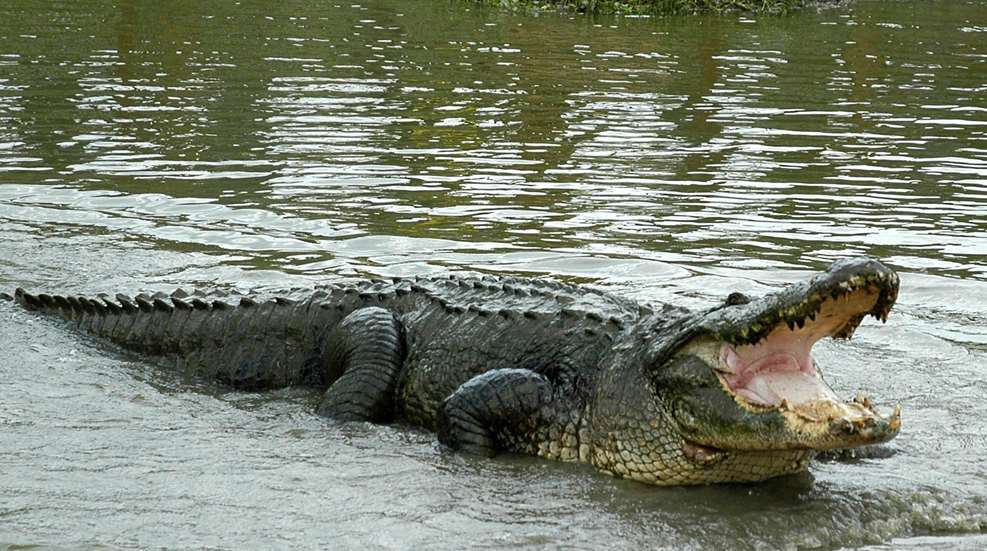
Women in the outdoors are increasing in number every year whether it’s through hiking, camping or hunting. Heading afield is a great way to relax and unwind. Just remember that even though getting off the grid is a sanctuary, it is not a place to let your guard down.
When you are enjoying the great outdoors, you are entering the world of the predator. There are two types of predators that you could encounter in natural areas. The first is human predators. Crime is more prevalent in National Parks and other natural areas than individuals may realize. The National Rifle Association lobbied hard so that we can carry firearms in National Parks and Forests in 2010 after several high-profile murders that occurred in national nature areas over the years.
The second category is animal predators. Large predators can be encountered in almost every part of North America. Being aware of the presence of large wildlife predators is crucial to avoiding a deadly situation. Outdoor enthusiasts should be knowledgeable about five main wildlife predators: black bears, brown bears, mountain lions, wolves and alligators. It is possible to encounter all of these animals in America depending on your region. These wildlife predators could absolutely pose a threat to your life. You should know where they live, how to avoid them, what to do if you see one and how to defend yourself against an attack.
Bears
The most common subspecies of black bear in North America is the western black bear. In the Southern United States, you will find the Florida black bear and the Louisiana black bear. Some states, like Texas, are fortunate enough to have two species. In the eastern part of Texas, you can find the Louisiana black bear, and in the western part of Texas you can find the western black bear. The rarer glacier black bear is found in a small part of Alaska.

This wildlife predator prefers a habitat with abundant cover. This cover is relative to the geographic region it lives. In the Eastern United States, that cover could be thick stands of timber or swamps. In the Western United States, it is found in high elevations in stands of pine or aspen trees. In the Southwestern United States, the black bear inhabits areas with sparse vegetation utilizing large stands of prickly pear cactus.
Male black bears can obtain a weight of up to 900 lbs., but rarely exceed 500 lbs. Females weigh between 120 lbs. to 300 lbs. When standing on its hind legs, these bears can reach a height of over 8’ tall.
The brown bear is the most widely distributed bear in the world. The brown bear has fourteen different subspecies, ranging from Europe, North America and Northern Asia, with a historical range in North Africa. There are two subspecies in North America. The most well-known is the grizzly bear and the second subspecies is the Kodiak or coastal brown bear.

The historical range of the brown bear in North America consists of the western part of the United States, from Alaska, most of Canada, southward to northern Mexico and eastward into Texas. The current range of the brown bear is the extreme northern part of Canada, Alaska and the Northwestern States: Wyoming, Montana, Idaho and Washington. Alaska is home to 98 percent of brown bears in the United States and 70 percent of these large wildlife predators in North America.

Brown bears prefer an open range with a clear and unobstructed view. They like open spaces between timberlines. These predators can often be encountered above the timberline on the open tundra of Northern Alaska or Western Canada. In its southern range, grizzly bears can be found in thick pine forest. They try to avoid the dense undergrowth that black bear prefer.
Male grizzly bears can obtain a weight between 500 lbs. to the extreme weight of 1,500 lbs. Females range between 400 lbs. and 600 lbs. Kodiak or coastal brown bears range between 500 lbs. to the extreme weight of 2,000 lbs. When a brown bear stands on its hind legs it can reach between 10’ to 12’ tall. In extremely large bears, the reach may be up to 15’ high.
How to Avoid Bears: Most encounters occur between sunset and sunrise. Bears are omnivores, so anything that smells like food can potentially attract bears. When camping, the only thing that should ever go into your tent is you and your sleeping bag. Everything else, especially food, toiletries and trash, needs to be hung in a bear bag high off the ground, between two trees, or in a designated bear box. If you are in black bear country, hang your bear bag at least 10 feet off the ground. If you are in brown bear country, hang it at least 15 feet off the ground.
When camping in the back country, it is very important to remember to cook at least 100 yards away from your camping area. Clean up any ground and dirt that is contaminated by spilled food and if you are hunting, all game should be hung in the bear bags at least 100 yards away from your camp. The idea is containing all “smellable” items to one area, away from you and your campsite.
When hiking through the woods, fresh bear signs such as tracks and scat, is an indication bears are in the area. Claw marks on trees, a nearby trout or salmon run or a fresh kill can also indicate bears are nearby. You should always hike with a buddy and make noise, so you do not surprise a bear along the trail. This can be hard to do if you are hunting, so rely upon your sixth sense: If something does not seem right, it probably is not. Always be on alert.
If you encounter a bear, avoid making eye contact, and whatever you do, DO NOT RUN! Running can cause a bear to instinctively attack. Make as much noise as possible and try to appear larger than life, as you slowly back away the way you came.
Climbing a tree to avoid a black bear is not advisable because of their hooked claws. Their claws are ideally adapted to climb trees and can quickly overtake you. Brown bears are not very good at climbing, but they are so large when they stand on their hind legs, they could easily reach you if you stop on a branch too low to the ground! Make sure you are at least 12-15 feet off the ground.
A bear will typically only attack if it is looking for a food source or defending itself or its cubs. If an attack is eminent, be prepared for a fight. Ideally, you should have bear spray readily available, and a firearm backup. Depending on the environmental conditions, you may have to resort to your firearm as your primary defense. If either a black bear or brown bear are following you or enters your tent, it is looking at you as a food source and you are going to have to fight. If a black bear attacks, punch, kick, fight, scream and do your best to stay upright. If a brown bear attacks, try to protect your neck and vitals and make as much noise as possible. If a bear is defending themselves or their cubs, get as far away from the area as you can, backing slowly away, and hopefully the bear will perceive the threat has stopped and leave you to nurse your wounds.
Mountain Lions 
The mountain lion is the most widely distributed large predator in the Western Hemisphere. The mountain lion’s range extends from Alaska, Southern Canada, Western United States, parts of Eastern United States, Mexico and throughout South America. The historic range of the mountain lion included all of the continental United States.
These animals are very adaptable, surviving in just about any geological area in the Western Hemisphere. Their habitat includes desert areas, coastal plains, mountains and dense woodlands. mountain lions can tolerate the most extreme heat of the hottest deserts to the extreme cold of the most northern part of its range.
Adult male mountain lions can weigh over 150 lbs. and be over 8 feet in length. Females can weigh up to 90 lbs. and be 7 feet in length. A mountain lion travels up to 50 miles per hour in short bursts. They can cover up to 40 feet per stride while running and can jump up to 15 feet up a tree.
How to Avoid Mountain Lions
Signs that mountain lions are present are tracks, scat, territorial scrapes or a fresh kill. Mountain lions are very curious animals, and it is not uncommon for them to watch you or follow you as you walk down the path. While you are being watched, they may be sizing you up to see if you are worth their effort to attack. They do not usually attack out of defense because they are secretive animals by nature. They would rather leave the area than have a confrontation. Many times, if an attack does occur, it is an ambush-type attack and oftentimes from above such as a tree or boulder.
As with bears, you should always carry bear spray, and consider a firearm as a backup if an attack is eminent. If you do not have bear spray or a firearm, your only other choice is to fight. People have successfully fought off mountain lions with a small pocketknife, if you keep your mind in the fight. The key to fighting off a mountain lion is to keep eye contact and make yourself look as large as you can and stay on your feet. If you have small children pick them up and hold them high or on your shoulders to appear larger. Most attacks are on young children so be extra vigilant when in mountain lion country.
Wolves
There are two species of wolves in North America. These are the gray wolf and the red wolf. The gray wolf is the only wolf in its native range in North America. The red wolf was extirpated in its natural range and now only exists on an island off the Carolinas, established to save the species. All other wolves in North America are gray wolves. These include the timber wolf, Mexican gray wolf and the Arctic wolf.

Gray Wolf

A red wolf in captivity.
The historic range of the gray wolf is every part of North America except the southeastern part of the United States. The southeastern part of the United States was the home to the red wolf. The present range of the gray wolf is Alaska, Canada, and the extreme northern continental United States. The gray wolf is the largest member of the canine family. Adult males can weigh up to 175 lbs. Females can weigh up to 120 lbs.
How to Avoid Wolves: Signs that you are in a wolf pack’s territory are tracks and scat. Many times, you can hear wolves communicating through barks, yelps and howls. An attack from wolves is more complex because they are pack animals. With wolves, climb the nearest tree or get high atop a boulder. Just get off the ground as quickly as you can. If an attack is eminent, kick, punch and yell, and appear as large as you can.
Alligators
American alligators are found throughout the southeastern United States. They live in 10 states, ranging as far north as North Carolina, throughout the Gulf Coast, and down to the northern tip of Mexico. Alligators can be found in freshwaters or brackish wetlands. This includes swamps, saltwater marshes, rivers, lakes and relatively small bodies of water.

Alligators commonly reach a length of 12 feet and there are reports of gators reaching up to 15 feet in length. These wildlife predators can weigh up to 800 lbs. Chance encounters with alligators in their native range are quite common. This aggressive predator is extremely dangerous because it can obtain a very large size and exists among people.
For example, Houston, Texas, is the fourth largest city in the United States. Houston’s major waterway, Buffalo Bayou, runs straight through downtown Houston and is full of alligators, many reaching up to 12 feet in length. Alligators can be found in neighborhood drainage ditches, in residential yards miles from any water, and even in backyard swimming pools.
How to Avoid Alligators: Alligators are often encountered when hunting in wetlands during warm periods of waterfowl season. They can also be encountered hiking around bodies of water. Extreme caution needs to be exercised when small children or dogs are with you near bodies of water in alligator territory. Alligators can be encountered anywhere in the South along the Gulf Coast at any time of the year, except when the temperature falls under 60 degrees Fahrenheit.
The best indication there are alligators in the area is seeing slides along the bank of the water’s edge. Slides are usually muddy and smooth areas where the gator slides into, and climbs out of the water. The best way to avoid alligators are to stay out of the water where gators are present. Females fiercely protect their nest. The problem is, their nest can be up to a mile from the water’s edge.
If you are attacked, you need to punch and kick and fight. An alligator eats its prey by spinning into a “death roll” and drowning its victim. Most people get bit when they try to capture or handle an alligator. If you are pulled into the water by a gator, the best thing to do, if you have the nerve, is to ram your fist or foot down its throat. This will open the palatal valve in their throat, causing water to rush in. The gator should spit you out because water is rushing down its throat, allowing you a brief time to make your escape.



Knowing what to look for to predict an unintended encounter can mean the difference between a tragedy and an enjoyable outing. By gaining an understanding of large wildlife predators, a life and death situation can be avoided. Animals are very unpredictable, but the biology and ecology of these animals remain fairly constant. If you understand the biology of animals and how they exist in a specific area, you can, with relative certainty, know how to prepare yourself when entering into their world.















































